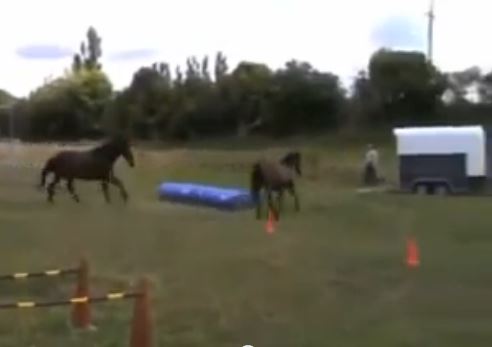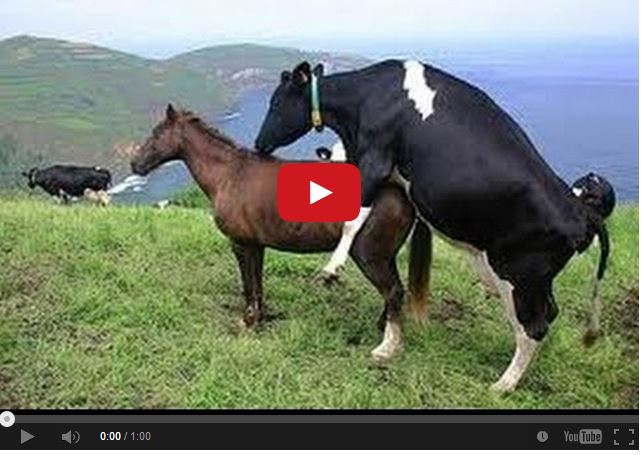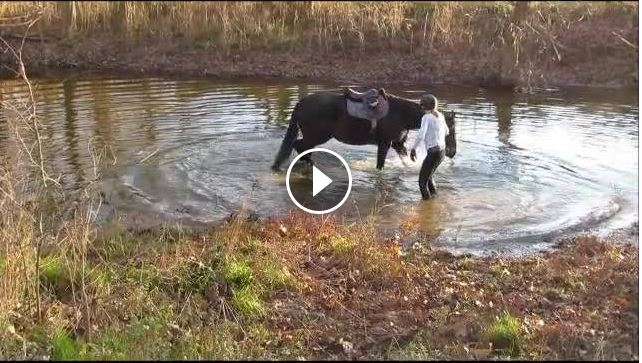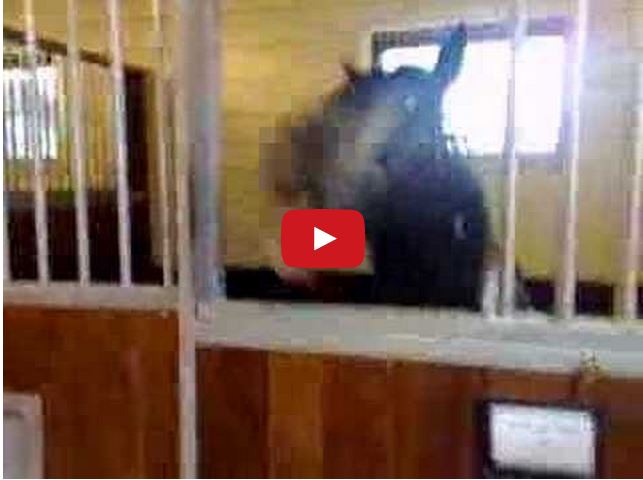10 Secrets to Understanding Your Horse’s Mind!
Here is a brief excerpt from a book written by renowned veterinarian and expert in ethology, Dr. Robert M. Miller, DVM.
Here is a summary of the ten traits every horse inherits. The following chapters discuss each trait in detail and explain how you can use each to your advantage when dealing with horses. Understanding these inbred characteristics will unlock the secrets of horse behavior.
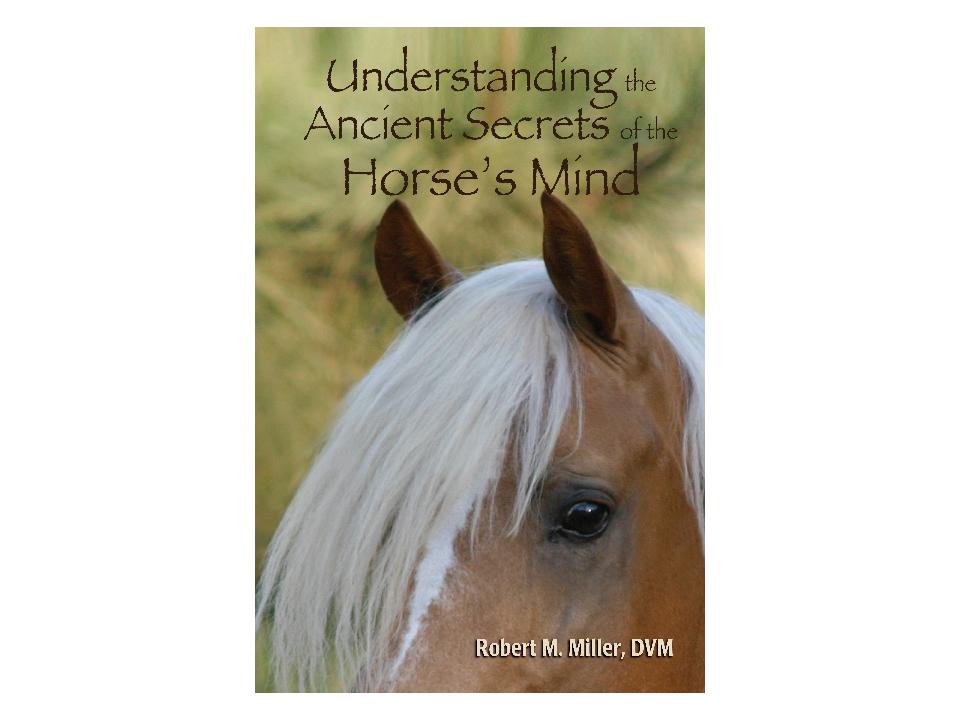 1. The Secret of Flight: The horse in its wild state depends upon flight as its primary survival behavior. The horse’s natural habitat is grasslands, prairie or steppes. Its primary enemies in nature are the large predators, particularly those of the cat and dog family, such as lions and wolves. Anatomically, physiologically and behaviorally the horse is a sprinter. Considering its enemies and its habitat, sprinting straight away from any frightening stimulus is the best way for horses to survive. To understand horses, above all else, the natural instinct of this species to flee from real or imagined danger must be appreciated
1. The Secret of Flight: The horse in its wild state depends upon flight as its primary survival behavior. The horse’s natural habitat is grasslands, prairie or steppes. Its primary enemies in nature are the large predators, particularly those of the cat and dog family, such as lions and wolves. Anatomically, physiologically and behaviorally the horse is a sprinter. Considering its enemies and its habitat, sprinting straight away from any frightening stimulus is the best way for horses to survive. To understand horses, above all else, the natural instinct of this species to flee from real or imagined danger must be appreciated
2. The Secret of Perception: Prey species must be more perceptive than predators if they are to survive. Horses are a prey species that live with the danger of being eaten by their predator enemies. They are programmed to be on the lookout for danger and are always prepared to flee from it in an instant. Inexperienced horsemen often fail to appreciate the extreme perceptivity of the horse. Horses have an uncanny ability to detect sensory stimuli that are far too vague for us to sense. We commonly interpret the flight reaction caused by the stimuli as “stupidity. Horses are incredibly aware of their surroundings, so much so that people often misinterpret the horse’s reaction as “psychic” or the result of a “sixth sense.” However, the responses, which elicit such opinions, are caused by reactions to the same five senses we possess: sight, hearing, smell, taste and touch. What is difficult for us to identify with is the superiority of those senses in the horse and the swift flight reaction that a stimulus to those senses can provok
3. The Secret of Response Time: The horse has the fastest response time of any common domestic animal. “Response time” or “reaction time” is defined as the ability to perceive stimuli and react to it. Prey species must have a faster response time than a predator or they get eaten. The horse is such a large animal that the speed of its response time is hard for us to comprehend. This short response time is essential in a flighty creature. It isn’t enough to run away. One must run away instantly and at high speed to survive.
4. The Secret of Rapid Desensitization: The horse is more quickly desensitized to frightening stimuli than any other animal. Why is a flight-oriented creature so quickly desensitized to frightening but harmless stimuli? If this weren’t so, horses would spend all their time running and there would be no time to eat, drink, rest, or reproduce. So horses, in nature, must quickly learn to ignore basically frightening but harmless things such as tumbleweeds, thunder, quail and other herbivorous prey species, such as bison, antelope, or deer. Once they learn, they never forget.
5. The Secret of Learning: Not only do horses desensitize faster than other domestic animals to frightening stimuli, but other kinds of learning are obtained with similar speed. If a novel experience, such as the first shoeing, the first trailer loading, the first saddling, the first worming, the first experience of any kind is traumatic, the horse will henceforth fear that procedure.
Conversely, if a novel experience is made pleasurable and if comfort rather than discomfort ensues, the horse will remember that and will be more accepting of such an experience in the future. The reason that great trainers are able to obtain results with startling swiftness, is due to the fact that they use technically appropriate behavior shaping techniques in a species which is inherently able to learn with great speed – a matter of survival in a prey creature which depends upon flight to survive.
6. The Secret of Memory: The horse’s memory is nearly infallible. Horses never forget anything! Fortunately, horses forgive and were it not for that fact, a majority of professional horse trainers could not make a living. Horses can and do survive inept, improper and inhumane training methods. Many of them manage to become satisfactory performers, although the information yielded by the relatively new sciences of ethology (scientific study of animal behavior in their natural surroundings) and behavior shaping show us that most of our traditional training methods are inefficient and cumbersome.
The donkey and its hybrid offspring, the mule, have as keen a memory as the horse, but unlike horses they do not forgive. Thus, donkeys and mules are notoriously more challenging to train than horses. All good mule trainers can train horses, but the reverse is not true. There is truth in the old saying, “Mules must be trained the way horses should be trained.”
Horses categorize every learned experience in life as something not to fear and, hence, to ignore; or something to fear and, hence, to flee. This is extremely useful in the wild and utilizes the species’ phenomenal memory, but it often creates problems in domestic situations. If a horse categorizes a harmless stimulus (such as an electric clipper, a piece of plastic, a white cat, a flag, a tractor, or a veterinarian, etc.) as something to run away from, it creates major problems to those of us who must handle it. What horses experience creates lasting attitudes, especially if the horses are young. It is incumbent upon those who must work with horses not to cause bad experiences that the horse will forever regard as a reason to flee. This makes it especially difficult for farmers and veterinarians because everything they do is frightening and some things are painful.
It is, therefore, the owners’ responsibility to desensitize (train) horses to accept such routine procedures as farriery, veterinary examination including invasion of the body openings and basic therapeutic procedures such as dentistry, intubation, and oral or eye medication.
7. The Secret of Dominance Hierarchy: The horse is the most easily dominated of all common domestic animals. It is a herd animal, subject to a dominance hierarchy and because it is a flight animal, the horse needs leadership to know when and where to run. In the wild, horses need leadership and readily accept it. Even naturally dominant individual horses (which are the exception in all animals that live in groups) can be dominated and rather quickly if one knows how to do it. The methods by which this can be accomplished most effectively are not natural to human beings. We must be taught.
8. The Secret of Control of Movement: The horse is the only common domestic animal that exerts dominance and determines the hierarchy by controlling the movement of its peers. It is understandable that in a species in which the ability to run away means life or death, positional control is the way in which leadership is established. Dominant horses make threatening movements towards subordinate herd members. The submissive individual, yielding its space, reaffirms the role of the dominant leader.
Control of movement is the basis of all horse training disciplines. Horses accept our dominance when we cause them to move when they’d prefer not to, or when we inhibit their movement. Thus, trainers use many techniques to control flight in the horse. These techniques include round pens, training rings, longe lines, driving lines, hobbles, lateral flexion of the head and neck, vertical flexion of the head, lateral control of the hind quarters, snubbing green colts to experienced horses and working them in harness next to an experienced horse.
9. The Secret of Body Language: Each species signals subordination or submissiveness with a body language instinctively understood by their own species. Horses give subtle signals when they are willing to submit to any domination. We must learn the body language of horses by experience or by education. As we shall see, the body language, or signalment, of horses is unique to the equine species. It is imperative that people handling horses learn to read the body language of their charges.
10. The Secret of Precocity: The horse is a precocial species, which means it is neurologically mature at birth. Commonly, the newborn of prey species is precocial. For example newly hatched chicks, ducklings, goslings, quail, grouse, newborn fawns, calves, lambs and foals are fully active soon after birth. Unlike kittens, bear cubs, puppies or newly hatched owls or hawks, all of which are predatory species and quite helpless at birth, the precocial species must be quickly able to recognize danger and flee from it.
The imprinting period of the precocial species is immediately postpartum, when they visualize and memorize what they see move and want to follow and respect it (which in nature is usually the mother). This helps them to stay with their dam and the herd and they are quickly imprinted to do so. In species with delayed imprinting periods this occurs much later (six or seven weeks in puppies, for example). These imprinting periods permit immediate learning and permanent retention. The best time to teach horses, therefore, is right after birth. Attitudes, temperament and reactions can be shaped in just a few hours if we know how.
The book will cover each of the above subjects in depth, and then describe how to solve behavior problems using this knowledge.
For more information on Dr. Miller or to purchase his book please visit:
http://www.robertmmiller.com/naho.html

